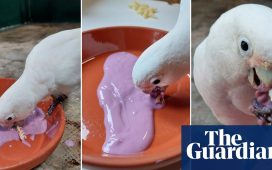Tim Radford, the Guardian’s former science editor and mentor to a generation of writers who followed in his footsteps, has died aged 84.
His reporting covered a breadth of topics from genetically modified crops and the environmental impact of greenhouse gases to the arrival of cloned animals and the discovery of gravitational waves, the ripples in the fabric of spacetime first predicted by Albert Einstein a century earlier.
Tributes to Radford recall a polymath whose infectious enthusiasm for science and talent for turning a phrase drew praise from university professors as much as the broader readership.
It was a role he revelled in, saying it was one of the few jobs in journalism where a writer got to tell stories no one had told before.
“Tim was a polymath,” said Sir Martin Rees, the astronomer royal. “He wrote for non-specialists, believing that science was part of our culture and that key ideas could be rendered accessible to us all.
“Even when his topic was one I thought I understood, he offered new insights and new metaphors. People with his eloquence and intellectual range are all too rare – he will be sadly and widely missed.”
Sir Paul Nurse, the Nobel laureate who will become president of the Royal Society for the second time later this year, called Radford “an excellent writer”, adding: “We will all miss him.”
Radford was born in New Zealand in 1940 and educated at Sacred Heart college in Auckland. He joined the New Zealand Herald as a reporter at the age of 16 and moved to the UK in 1961. After a brief spell as a Whitehall information officer, he spent the rest of his career in newspapers, joining the Guardian as a subeditor in 1973. He worked as the letters editor, arts editor and literary editor before becoming the science editor in 1992.
Claire Armitstead, a former literary editor at the Guardian, said: “Tim was the best sort of journalist: infinitely inquisitive and excited by the hugeness and variety of the universe, and indulgent of those who lacked his ability to comprehend it.”
Radford won Association of British Science Writers awards four times and received a lifetime achievement award in 2004, the first year it ran. The following year the award went to Sir David Attenborough.
Beyond his journalism, Radford was a revered mentor to many up-and-coming writers. On being invited to do some media training, he bashed out 25 commandments for aspiring journalists. The rules remain required reading today. One urges writers to imagine a little sign on their desk that declares: “Nobody has to read this crap.”
He offered more bespoke advice, too. When one journalist confessed to feeling paralysed by the responsibility of the job, he responded: “My experience of journalism is if you’re not hounded by fear, panic and a profound sense of inadequacy, then you’re doing it wrong. Complacency doesn’t get good stories written, ever.”
He stressed the importance of simple words, clear ideas and short sentences, while not forgetting a sense of irreverence. In a demonstration of the latter, he reported on the Blair government’s long-awaited response to the risk of an asteroid clattering into the Earth: a new information centre to be built in Leicester.
“He could talk as easily to Nobel laureates as he could undergraduates, and he could make any subject, however obscure, seem fascinating,” said Chris Mihill, a former medical correspondent at the Guardian. “He was a wonderful raconteur and could completely capture an audience, yet he always ended on a self-deprecating note. Then on the way out he would casually tell you why Shakespeare prefigured Wittgenstein by about 400 years.”
Radford wrote three books: The Crisis of Life on Earth, The Address Book, and The Consolations of Physics. Will Francis, his agent at Janklow & Nesbit, said: “From age 16, leaping from a launch on to the gangway of a heaving cruise ship as it came into Auckland’s harbour to interview Robert Mitchum, to patrician science journalist, father figure to a whole generation of writers, Tim never lost his extraordinary combination of perspicacity and intellectual humility. As he said: ‘You begin any journalism with the understanding that it’s very easy to get things wrong.’”
Alok Jha, the science and technology editor for the Economist, said: “Tim was the best of us, and such enormous fun. He not only knew about everything – from cosmic inflation to Neanderthal culture – but he effortlessly wove those strands of knowledge into magical, captivating stories. He was inexhaustible in his kindness, mentorship and support for many generations of writers and scientists who have wanted to help the world understand complex ideas.”
Radford is survived by two children, a granddaughter and a great-granddaughter.














